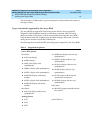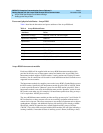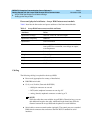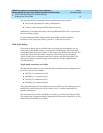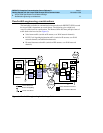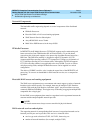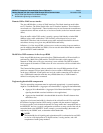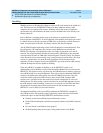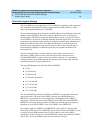
DEFINITY Enterprise Communication Server Release 9
Getting Started with the Avaya R300 Remote Office Communicator
Issue 1
November 2000
Avaya R300 Specifications and Network Design
24Bandwidth engineering considerations
2
Shuffling
Shuffling refers to an IP endpoint’s ability to redirect its IP audio stream in the middle of a
call. This feature is new for DEFINITY Release 9. Most endpoints made by other
companies are not capable of this feature. Shuffling reduces the resources required to
switch audio calls, and eliminates the need to involve the Media Processor directly in an
IP networked call.
Prior to Release 9, all audio streams were set up between an endpoint and a Media
Processor board on DEFINITY. If one IP endpoint called another, the IP audio was routed
to a Media Processor board, converted to TDM audio, routed back to a Media Processor
board, converted back to IP audio, and finally routed to the other IP endpoint.
This IP-TDM-IP model made things easier for the IP endpoints, but had drawbacks. First,
the call between 2 IP endpoints used resources on the Media Processor board and
DEFINITY backplane, even though the audio was simply looping back out to the IP
network. The second drawback was that the audio quality suffered due to the unneeded
conversion from IP audio to TDM audio and back again to IP audio. Finally, the distance
of the IP routed call was unnecessarily long, causing increased network delays. For these
reasons, it is preferable to set up the IP audio connection directly between two IP
endpoints. For this to happen, however, the DEFINITY processor must have R9 software
and both IP endpoints must be capable of shuffling.
If the Avaya R300 is incapable of shuffling, or if the DEFINITY switch is not
administered to allow shuffling, all calls route through the Media Processor board on the
DEFINITY. This applies even to calls from one Avaya R300 station to another, or from an
Avaya R300 station to an Avaya R300 trunk. Thus, calls would use additional DEFINITY
resources and exhibit poor audio quality due to the IP-TDM-IP conversion. The calls
would also utilize unnecessary DSP resources in the Avaya R300, and these DSP
resources are a valuable resource that could easily become exhausted if all calls were
utilizing them. The audio quality could also decrease for Avaya R300 endpoints because
the audio packets would be making, in most cases, two trips across the WAN link. Since
all remote calls would be unnecessarily routed across the toll network back to the
DEFINITY, costs for WAN service would increase.
To implement shuffling on the Avaya R300, administer the DEFINITY to shuffle all
Avaya R300 stations and signaling groups. Specifically, enable the Direct IP-IP Audio
Connections option on the following DEFINITY administration screens:
■ Globally, on the Feature-Related System Parameters screen
■ On the IP Network Region screen that corresponds with the Avaya R300’s network
region
■ For each station on the Station screen (page 2)
■ On the Signaling Group screen (only if using trunks on the Avaya R300)



